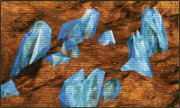Resources form the basis of your governance, allowing you to create facilities and units, expand your population, and of course, engage with other factions. Resources are the essential elements which you extract from your surroundings to support and expand your faction. There are three types of resource—nutrients, which support your population and allow your bases to grow in size; minerals, which allow you to build units and facilities; and energy, the currency of Planet. To obtain the resources from any given square, it must be inside your territory, inside the production radius of a base (within a two-square radius, excluding diagonals), and that base must assign a unit of its population to work that square.
Unworked squares yield no resources, regardless of their fertility. Your ability to exploit territory is limited by your technology. When you first arrive on Planet, you are generally unable to recover more than two of any one resource per turn. As you acquire new technologies, your production capacity expands until you are fully able to exploit the resource potential of every square in a base’s production radius.
Nutrients[ | ]

For your faction to increase, you must be able to extract healthy nutrients from the alien ecosystem of Planet. The more nutrients a base produces, the faster and larger it can grow. Every citizen at a base must "eat" two Nutrients per turn to survive. Surplus nutrients are stored. When sufficient surplus nutrients have been accumulated, a base will grow, producing a new citizen.
Rainfall directly determines the amount of nutrients a square can produce. There are three levels of rainfall on Planet—arid, moist and rainy. Rainy squares show as green on the map, and are usually the best places to establish new bases. Arid squares show up as brown, and moist squares combine green and brown. When scouting for new settlements, always remember, “Green is good.”
Without any modifiers (such as special resources, enhancements, xenofungus, monoliths and others, all detailed below):
- an arid square produces no nutrients,
- a moist square produces 1 nutrient per turn,
- a rainy square produces 2 nutrients.
Rocky squares do not produce nutrients regardless of rainfall.
Moist and rainy squares are excellent places to build farms to enhance nutrient production. The amount of nutrients any given square can produce is limited until the discovery of Gene Splicing.
Minerals[ | ]

Mineral production controls the rate at which your bases improve, as well as your ability to produce military, transport and terraforming units. Existing units may also require a certain amount of mineral raw materials for support. Once a base has exceeded its free support level, any additional units (military or non-combat) consume one Mineral per turn of support. Surplus minerals are applied to production of facilities, units, and secret projects which a base is creating. When sufficient minerals are accumulated, the facility or unit is built.
The rockier a square, the more minerals it produces. There are three levels of rockiness—flat, rolling and rocky. Without any modifiers (such as special resources, enhancements, xenofungus, monoliths and others, all detailed below):
- a flat square produces no minerals,
- a rolling or rocky square produces 1 mineral per turn.
Bases cannot be established in rocky squares, nor can farms be started there. They are, however, excellent places for mines.
The amount of minerals any given square can produce is limited until the discovery of Ecological Engineering.
Energy[ | ]

Energy is produced in squares with solar collectors, particularly those at high Altitudes. Depending on the Energy Allocation which you have made on the Social Engineering screen, all the energy you produce is divided among three priorities: Economy, Labs, and Psych.
The energy you collect is allocated to three different areas: Economy, Labs and Psych. Energy allocated to Economy is used to maintain base facilities; any excess is placed in the energy reserve. Your faction’s economic power is measured by its energy reserves. These reserves are saved in the form of “energy credits,” and are used for maintaining base facilities, commerce and energy payments between factions. Energy from the energy reserves may also be invested in mineral production to hurry projects to completion. Energy allocated to Labs speeds research into new technologies. Energy allocated to Psych helps maintain order in your bases.
Squares with solar collectors produce 1 energy per level of elevation. There are four levels of elevation above sea level on the Planet:
- 0 to 1,000 meters above sea level, producing 1 point,
- 1,000 to 2,000 meters, producing 2 points,
- 2,000 to 3,000 meters, producing 3 points,
- and above 3,000 meters, producing 4 points per turn.
You can find the elevation of a square by checking it in the Status View. You can also see elevations and depressions on the map.
The amount of energy any given square can produce is limited until the discovery of Environmental Economics.
Inefficiency[ | ]
Some of the energy a base produces may also be lost to inefficiency.
The formula used to compute the energy lost to {Inefficiency} by a base is:
- Inefficiency = (Energy * Distance / (64 - ((4 - Efficiency) * 8))
Where:
- Energy: Amount of energy produced by base this turn.
- Distance: Distance from Headquarters base (16 if no HQ).
- Efficiency: Social Engineering EFFICIENCY rating (+2 ifChildren's Creche is present).
If the denominator reaches zero, ALL energy is lost to inefficiency. The social engineering rating is perhaps the most pivotal, as at negative levels, losses due to distance increase severely. At -2 rating, the loss is effectively doubled.
- For example, a base 16 units away from headquarters loses 50% Energy to inefficiency at 0 rating, but 100% at -2. At +2 it will lose 33%, while at +5 the loss is reduced to ~22%.
